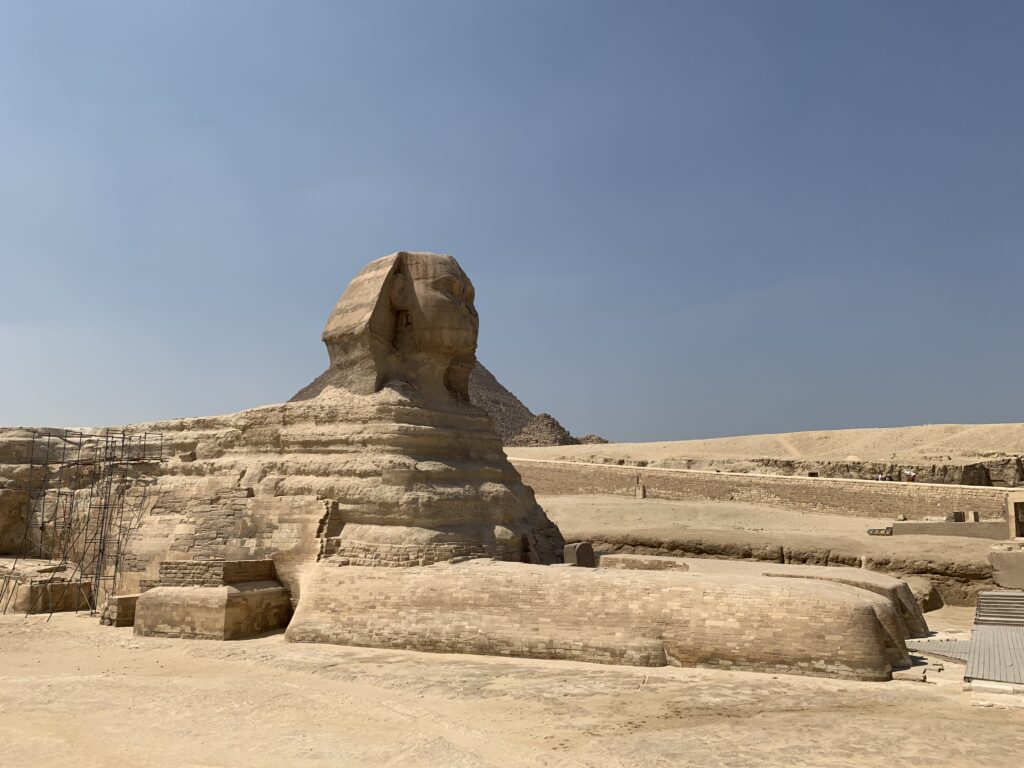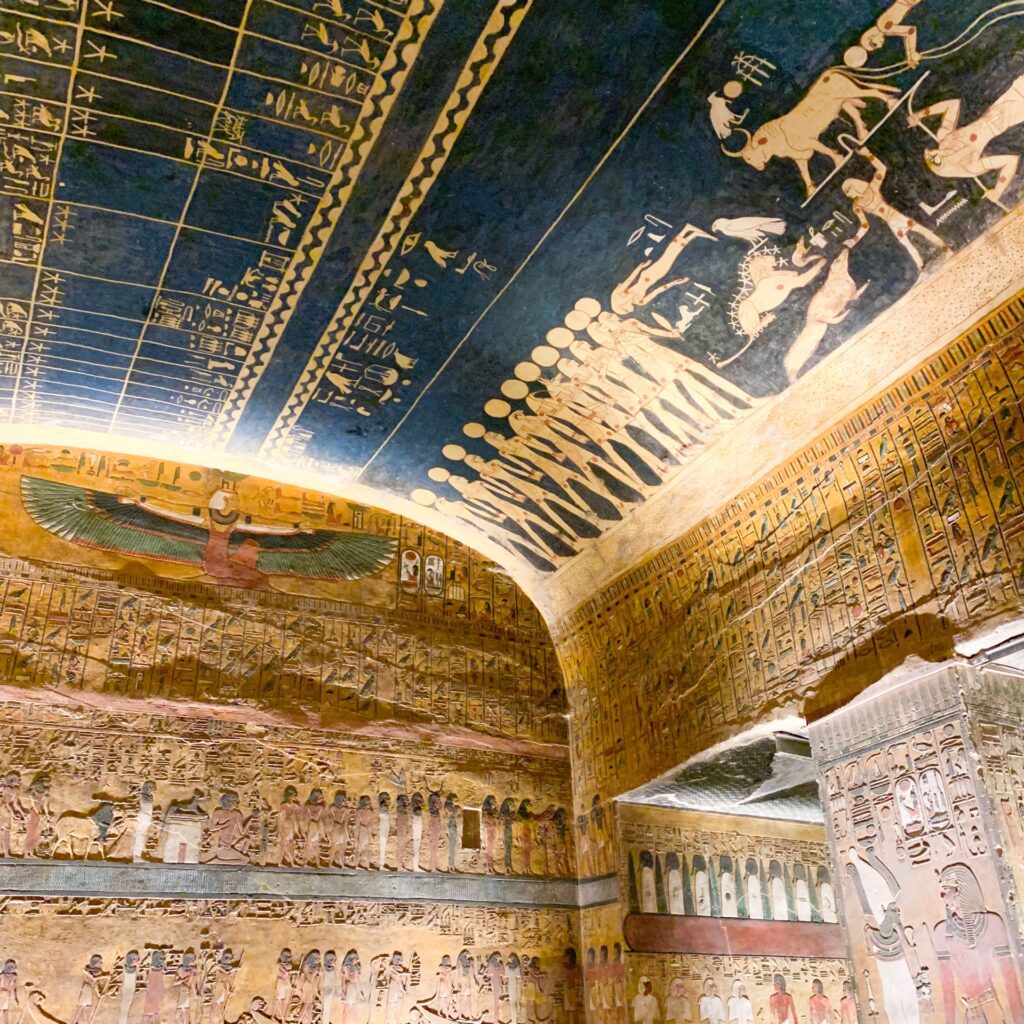A trip to Egypt is where old meets new and cultures collide, with surprises and mysteries around every corner. It’s a cacophony of sights, sounds, and smells that will immerse you in the history of this dynamic country, and having the right guide can make your trip to Egypt easy, seamless, and memorable. When I visited Egypt with Extraordinary Journeys, we traveled with Mohamed Shatta, an Egyptologist who’s worked as the inspector of antiquities at Giza and has spent his life devoted to deciphering and understanding the ancient Egyptians. He was indispensable, an expert who turned a wall of hieroglyphics into a compelling narrative that continued to unravel throughout the trip as he accompanied us to new sites each day. From the ancient secrets of Cairo to the awe-inspiring temples of the Nile, here are the highlights of an unforgettable trip to Egypt.
1. Cairo


While it’s one of the biggest cities in the world, Cairo travel still feels ancient. On our first day, Mohamed took us straight from the airport to the heart of Medieval Cairo, where he led us down a stairway into a warren of narrow, winding alleyways with vendors selling jewelry and lamps, as well as antique photographs and books. Our first stop was one of the oldest Coptic churches in Cairo, an ancient stone cathedral. From there, we wandered to Ben-Ezra Synagogue, a breathtakingly stunning marble building that’s said to be built on the site where baby Moses was found. Since we saw a Christian church and a Jewish synagogue, the next step to understanding Cairo was a visit to the Mosque and Madrassa of Sultan Hassan, a religious school built in the 14th century by Sultan an-Nasir Hassan, a ruler known for his extravagant spending. Enormous and intricately carved, it’s a gorgeous monument with views of the nearby neighborhoods.
2. Pyramids of Giza
No visit to Cairo is complete without a stop at the Pyramids at Giza. Arguably one of the most iconic structures on the planet, the sheer scale of the pyramids is a wonder to behold. Nearby, the famous Sphinx made for a great photo backdrop before we were treated to a sneak peek of the Grand Egyptian Museum, which will hold some of the world’s most important ancient treasures once it opens to the public later this year with more than 100,000 artifacts.
After a day of exploring Giza, we spend the night at the historic Marriott Mena House, a slice of paradise where almost every room has a view of the pyramids.



3. Luxor
From Cairo, we boarded a short flight to Luxor, the Arab name for the ancient city of Thebes, in order to start our Nile cruise. We visited Luxor Temple at sunset, just as the sky was turning into pink and violet pastels and lights around the temple put the carvings in stark contrast. The crumbling temple felt like an extension of the city, just across the street from the bustling downtown full of hotels and tourist markets along the river. At night, the energy at the temple was jubilant, with local kids running around, and a boisterous feeling of revelry as Mohamed told us the story of the temple and the kings that helped shape it over the centuries.
4. Valley of Kings
On the west bank of the Nile across from Luxor is the Valley of Kings, the burial site of Egypt’s pharaohs. Though it’s small in comparison to the decadence of grander pharaohs like Ramses IX or Ramses III, King Tutankhamun’s tomb is the most famous modern discovery in the Valley of Kings and is a must-see on most people’s trip to Egypt itineraries. The tomb is the only one that was untouched by grave robbers before its rediscovery–when it was unearthed in 1922, it was full of riches and artifacts, including King Tut’s golden sarcophagus, which has been the highlight of exhibitions around the world. While the treasures of other tombs have long been lost to grave robbers–or yet to be discovered, they are still worth visiting for the elaborate murals and vast underground chambers. The highlight of our day was a visit to the tomb of Sety I, a pharaoh who led ancient Egypt through a period of prosperity by expanding the empire into modern-day Syria. His tomb, the longest and deepest in Valley of the Kings, that’s not open to the general public, but Extraordinary Journeys gave us exclusive access. As the only visitors to the tomb, it was a surreal feeling to witness the beautifully carved reliefs, brilliant blue burial chamber, and multilevel passageways in total silence.



5. Temple of Hatshepsute
Like something out of a movie, the Temple of Hatshepsut rises from the desert in front of sandstone cliffs. Hatshepsut, the second confirmed female Pharaoh who ruled as both regent and rightful heir to the throne since she and her husband, Thutmose II, were half-siblings both fathered by Thutmose I. During her 22-year reign, Hatshepsut reestablished trade routes, and launched ambitious construction projects, like the multilevel Temple of Hatshepsut. The massive mortuary temple has shrines to the goddess Hathor and to Anubis, the god of death. It’s a marvel of ancient engineering, with stone terraces, columns, and porticoes.

6. Karnak
Luxor is home to enough fascinating sites to fill a lifetime. In addition to Luxor Temple, the Temple of Hatshepsut, and the Valley of the Kings, there’s also the Temple of Karnak. The largest religious complex in Egypt, it’s a patchwork of temples, courtyards, chapels, and more. One of the most notable sites within Karnak is the Hypostyle Hall at the Temple of Amun-Ra, a vast room of enormous carved pillars that feels like a forest of stone. After a busy day of temples and tombs, we spent the night at the Sofitel Winter Palace, a historic hotel that felt like walking through the pages of a novel.


7. Edfu, The Temple of Horus
In Luxor, we boarded a traditional Dahabiya (a small sailing ship) to explore the rest of the temples along the Nile—a must on any trip to Egypt. Our boat, the Nebyt Dahabiya, had six cabins and one luxury suite on the main deck, while the upper deck was an open area with a bar, dining area, lounge, and a canopy for much-needed shade. Different from traditional river cruise ships, a Dahabiya is a low, wooden boat built in the traditional style with sails at either end. Our first stop was the Edfu, one of the best-preserved temples in Egypt. Sailing on smaller boats means you can beat the cruise ship crowds and since we were the only visitors to the temple, it felt like we had stepped through a portal to the past, marveling at the colorful stucco murals and an array of hieroglyphics. While other temples in various states of disrepair might have missing walls or roofs that let in light, Edfu’s structure is nearly intact, lending the site a dark and almost spooky atmosphere.



08. Kom Ombo, The Temple of Sobek
Kom Ombo is dedicated to Sobek, the crocodile-head deity that was a reminder of the river’s dangers. While there are no longer crocodiles in this part of the Nile, the temple has a dungeon-like well that used to serve as a sort of aquarium for the ferocious creatures. Next door, a small museum has mummified and taxidermy crocodiles that made us think twice about swimming in the Nile.

The Temple of Horus at Edfu, Egypt Image by Teddy Minford
9. Philae
The last temple on our trip, Philae is dedicated to the goddess Isis, wife to Osirus, and mother of Horus. She was revered as a mother figure and was believed to be a guide for the afterlife after having resurrected her husband after he was murdered by his brother. Situated on an island in the river that’s only accessible by boat, Philae was moved piece-by-piece from its original location before the Aswan Dam was completed in 1970.
10. Aswan
The city of Aswan was the last stop on our Nile cruise and a perfect send-off. With ancient temples and Nubian villages, Aswan feels tethered to the past, while the buzzy night market is full of stalls selling everything from plastic light-up tchotchkes to replica artifacts, local herbs, and a dizzying selection of sweets and snacks. It was 109 degrees when we pulled into Aswan, but after sunset, the temperature went down and it seemed the entire city was out shopping or gliding along the river in boats bedecked with flashing lights and loudspeakers.
Aswan is also home to one of Egypt’s most luxurious hotels, the Sofitel Legend Old Cataract Hotel, where Agatha Christie wrote Death on the Nile and a sumptuous suite bears her name. Mixing old-world elegance and ancient traditions with modern comforts like plush beds and an oasis-like pool overlooking the river, it’s the perfect place to spend your last night of your trip to Egypt.



Born in London and raised in Warsaw, Poland and Ketchum, Idaho, Teddy Minford has spent her life traveling. Focusing on hotels, food, adventure, and art, her writing has taken her all over the world, from treehouse hotels in Sri Lanka to remote wineries in Argentina. Her words can be found in Fodor’s, Condé Nast Traveler, Forbes, and Travel + Leisure and she’s the author of a guidebook to the Hamptons, Long Island, and the Jersey Shore. She lives in New York City. Follow along her travels on Instagram.
